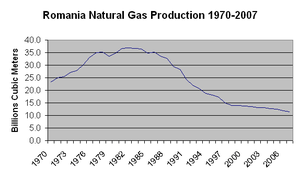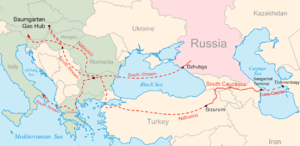Natural gas in Romania

Romania has proven natural gas reserves of 726 billion cubic meters (25.94 trillion cubic feet) and is ranked 30th among countries with proved reserves of natural gas.[1] About 75% of Romania's natural gas resources are located in Transylvania, especially in Mureş and Sibiu counties.[2] The largest natural gas field in Romania is the Deleni gas field discovered in 1912 and located in the Băgaciu commune in Mureş County with proven reserves of 85 billion cubic meters or 3 trillion cubic feet.[3] Other important gas fields include the Filitelnic gas field (40 bcm - 1,430 bcft),[4] the Roman-Secuieni gas field (24 bcm - 850 bcft),[5] the Voitinel gas field (11.8 bcm - 415 bcft),[6] the Gherceşti gas field (11 bcm - 400 bcft)[7] and the Sărmaşel gas field (10 bcm - 354 bcft)[8] all with reserves larger than 10 billion cubic meters or 350 billion cubic feet. Currently Romania has the third largest natural gas reserves in the European Union just after the Netherlands and United Kingdom.[1]
History
On the present-day territory of Romania, the first natural gas deposit was discovered in 1909, in Sărmăşel, Mureş County (then in Austria-Hungary), further to geological researches on potassium salts. The first gas production was used to power the steam boilers in Sărmăşel and the gas lighting of the alleys in Bazna resort. The first gas transmission pipeline was built in 1914 covering the 55 kilometres (34 mi) between Sărmăşel and Turda, with the last being the first city in Europe to have public street lights fueld by natural gas in 1916.[9][10] In 1927 the first natural gas compression station in Europe was built in Sărmăşel.[9] Following the successful gas discovery many foreign companies started to prospect the territories including American, British, French and Austria-Hungarian companies. The American success in the exploitation and usage of natural gas determined the foundation of Societatea Maghiara de Gaz Metan UEG (Hungarian Methane Company) by the Hungarian Ministry of Finances and Deutsche Bank whose scope of activity was the exploration, exploitation, transmission, distribution and use of natural gas in certain regions within Transylvania. A prodigious period followed for the gas distribution business and the year 1941 marks the construction of the first natural gas pipeline from Măneşti to Bucharest, while the following year a main pipeline is built for the transportation of natural gas from Transylvania to the capital city.[10] After the unification of Transylvania and Romania in 1919 the Direcția gazului natural company is established at Cluj Napoca affiliated to the Ministry of Industry and Commerce in Bucharest, which later in 1925 was renamed to Societatea Națională de Gaz Metan SONAMETAN (National Methane Company). The first underground storage facility in Romania was built in 1958 at Ilimbav in Sibiu County and in 1959 Romania becomes the first natural gas exporter in Europe, the destination being Hungary.[10] 1979 represents the beginning of natural gas imports in Romania from Russia then part of the Soviet Union.[10]
Production
The local natural gas production is dominated by two very large companies Romgaz with a market share of 51.25% and Petrom with a market share of 46.33%. There are also several smaller companies Aurelian Oil&Gas with a market share of 0.38%, Amromco with a market share of 1.85%, Lotus Petrol with a market share of 0.13% and Wintershall with a market share of 0.06%.[11][12] In 2009 Romania produced around 11 billion cubic meters of natural gas (400 billion cubic feet) which represented 85% of all gas consumed in the country.[12] Romania ranks fourth in the European Union in terms of natural gas production just after the United Kingdom, Netherlands and Germany.[13]
In 2009 the largest natural gas producer in Romania was Romgaz which produced 5.76 billion cubic meters (204 bcft),[14] Petrom came second with around 5 billion cubic meters (177 bcft) and Aurelian Oil&Gas, Amromco, Lotus Petrol and Wintershall produced a combined 0.24 billion cubic meters (8.5 bcft).[14] Around 62.5% of the total natural gas extracted in Romania in 2009 came from the Mureş County.[15]
Storage
Romania has eight underground storage facilities with a combined capacity of 3 billion cubic meters (106 bcft).[16] Of the eight, six are operated by Romgaz and two are operated by Depomureş and Amgaz. The Romgaz underground storage facilities have a combined capacity of 2.76 bcm (98 bcft).[17] The storage facilities are located in Sărmăşel and Cetatea de Baltă in Transylvania and in Bilciureşti, Bălăceanca, Urziceni and Gherceşti in Southern Romania.[17] The largest of the six storages is the Bilciurești facility located 40 km (25 mi) North - North - West of Bucharest having a storage capacity of 1.3 bcm (46 bcft) in one cycle and it is located at a depth of 2,000 m (6,600 ft).[17]
Romgaz also has plans to increase the capacity of its underground storage facilities to around 4 bcm (142 bcft) by 2013.[16] The company also signed a memorandum with Russian company Gazprom for the development of ten underground storage facilities with a maximum capacity of 5 billion cubic meters (177 bcft) of which 2 bcm (71 bcft) will be at the Roman-Mărgineni facility located in Bacău County.[18] Other companies interested are GDF Suez who wants to develop an underground storage facility with a capacity of 0.5 billion cubic meters (18 bcft) and EGL Power who wants to develop an underground storage facility with a capacity of 0.3 billion cubic meters (11 bcft).[16]
Reserves
Romania has proven natural gas reserves of 630 billion cubic meters (22.94 Tcf) and is ranked 30th among country's with proved reserves of natural gas.[1] Most of Romania's natural gas resources are located in Transylvania, Moldavia, Wallachia and the Black Sea with around 75% being located in Transylvania especially in Mureş and Sibiu counties.[2] The most important natural gas fields in Transylvania are Abrămuţ, Bazna, Benţid, Brădeşti, Copşa Mică, Cuşmed, Deleni, Filitelnic, Firtuşu, Ibăneşti, Laslău Mare, Salonta, Sărmaşel, Sighişoara, Şamşud and Zau de Câmpie. The most important natural gas fields in Moldavia are Bătrâneşti, Berbinceni, Bilca, Brodina, Gherăieşti, Roman-Secuieni and Voitinel. The most important natural gas fields in Wallachia are Bobocu, Boldeşti-Scăeni, Bustuchin, Gherceşti, Grădiştea, Mamu, Măneşti-Vlădeni and Torceşti. The most important natural gas fields in the Black Sea are Ana, Doina, Lebăda Est, Lebăda Vest, Pescăruş and Sinoe.
The largest natural gas field in Romania is the Deleni gas field discovered in 1912 and located in the Băgaciu commune in Mureş County with proven reserves of 85 billion cubic meters or 3 trillion cubic feet.[3] Other important gas fields include the Filitelnic gas field (40 bcm - 1,430 bcft),[4] Roman-Secuieni gas field (24 bcm - 850 bcft),[5] the Voitinel gas field (11.8 bcm - 415 bcft),[6] the Gherceşti gas field (11 bcm - 400 bcft)[7] and the Sărmaşel gas field (10 bcm - 354 bcft)[8] all with reserves larger than 10 billion cubic meters or 350 billion cubic feet.
Transmission system

The national natural gas transmission system in Romania is owned by Transgaz a state-owned company. It has a total network length of 13,110 km (8,150 mi) of pipelines with diameters between 50 mm (2.0 in) and 1,200 mm (47 in).[19] The company also owns a 50% stake in the Arad–Szeged pipeline, a natural gas pipeline from Arad in Romania to Szeged in Hungary, with a length of 109 km (68 mi) and a transport capacity of 4.4 billion cubic meters (0.15 Tcf) per year,[20] a 16.67% stake in the Nabucco pipeline, a natural gas pipeline from Erzurum in Turkey to Baumgarten an der March in Austria, with a length of 3,300 km (2,100 mi) and a transport capacity of 31 billion cubic meters (1.1 Tcf),[21] a 50% stake in the Giurgiu–Ruse pipeline, a natural gas pipeline from Giurgiu in Romania to Ruse in Bulgaria, with a length of 190 km (120 mi) and a transport capacity of 2 billion cubic meters (0.07 Tcf) per year,[22] and a 33% stake in the Azerbaijan–Georgia–Romania Interconnector a project to transport Azerbaijani natural gas to Romania via tankers over the Black Sea.[23] The national natural gas transmission system has an annual transport capacity of 30 billion cubic meters (1.05 Tcf).[24]
Romania also has four other pipeline links to Ukraine used for the import or transit of natural gas. One of the pipelines enters the country at Medieşu Aurit in Satu Mare County in the North - West of the country. This pipeline has a transport capacity of 4 billion cubic meters (0.14 Tcf) per year.[25] The other pipelines are used mainly for transit and enter the country at Isaccea in Tulcea County and exit at Negru Vodă in Constanţa County. The first of the pipelines was built in 1974, the second in 1986 and the third in 1996. The pipelines have a length of 190 km (120 mi) each and a combined transport capacity of 28 billion cubic meters (0.98 Tcf).[22] They are used to supply natural gas to Bulgaria, Greece, Republic of Macedonia and Turkey.[22][26] Romania earns around €60 million per year from transit fees from these pipelines.[27]
References
- 1 2 3 "Europe's energy position past & future" (PDF). ec.europa.eu. Retrieved September 13, 2010.
- 1 2 "Production" (in Romanian). Romgaz. Retrieved August 20, 2010.
- 1 2 Giant oil and gas fields of the decade. American Association of Petroleum Geologists. 1999. Retrieved 2010-09-13.
- 1 2 "Feasibility study for the enhancement of the Filitelnic gas field, Romania". FBODaily. 2001-11-11. Retrieved 2009-02-24.
- 1 2 "Aurelian tests positive gas flow from onshore Romanian gas discovery". Scandoil. 2009-02-16. Retrieved 2009-02-22.
- 1 2 "Romania - EIII-1 Brodina Block: Exploration". Europa Oil & Gas. 2010. Retrieved 2010-09-07.
- 1 2 "International exploration development" (PDF). eia.doe.gov. 1995. Retrieved 2010-09-08.
- 1 2 "Gazul natural" (PDF) (in Romanian). BCU Cluj. 2009. Retrieved 2010-08-23.
- 1 2 "100 de ani de la descoperirea si utilizarea gazelor naturale pe teritoriul Romaniei" (in Romanian). Asociatia Generala a Inginerilor din Romania. Retrieved August 20, 2010.
- 1 2 3 4 "Company Background" (in Romanian). Romgaz. Retrieved August 20, 2010.
- ↑ "Raport anual de monitorizare pentru piata interna de gaze naturale - 2009" (in Romanian). ANRE. 2009. Retrieved 2010-09-13.
- 1 2 "Micii producători de gaze naturale din România vor să facă investiţii de circa 5 mil. euro în 2010" (in Romanian). money.ro. 2010. Retrieved 2010-09-13.
- ↑ "World Mineral Production 2003-2007". British Geological Survey. 2010. Retrieved 2010-09-13.
- 1 2 "Romgaz estimează că producţia de gaze va scădea uşor în 2010, la 5,65 miliarde metri cubi" (in Romanian). money.ro. Retrieved August 20, 2010.
- ↑ "Infrastructură" (in Romanian). Camera de Comerţ şi Industrie Mureş. 2010. Retrieved 2010-09-13.
- 1 2 3 "BERD vrea să finanţeze depozite de gaze în România" (in Romanian). Adevărul. 2009. Retrieved 2010-09-13.
- 1 2 3 "Storage" (in Romanian). Romgaz. Retrieved August 20, 2010.
- ↑ "Memorandumul Romgaz-Gazprom a fost prelungit pana in mai 2011" (in Romanian). Wall Street Journal. 2010. Retrieved 2010-09-13.
- ↑ "Infrastructura Sistemului Naţional de Transport Gaze Naturale (S.N.T.)" (in Romanian). Transgaz. 2010. Retrieved 2010-09-14.
- ↑ "Conducta de gaze Arad-Szeged va fi operaţională din această lună" (in Romanian). Adevarul. Retrieved August 25, 2010.
- ↑ "RWE 'to join Nabucco fold'". upstreamonline.com. 2008-01-22. Retrieved 2010-09-14.
- 1 2 3 "Momente semnificative privind istoria gazelor naturale din România" (in Romanian). Transgaz. 2010-09-14. Retrieved 2010-04-13.
- ↑ "Romania, Georgia, Azerbaijan sign agreement to build gas terminals". Xinhua. 2010-04-13. Retrieved 2010-04-13.
- ↑ "Indicatori tehnici". Transgaz. 2010. Retrieved 2010-04-13.
- ↑ "Transgaz va moderniza statia de import gaze Mediesu Aurit cu 1,75 mil. lei" (in Romanian). Wall Street Journal. 2009-11-23. Retrieved 2010-04-14.
- ↑ "Departamentul tranzit gaze naturale" (in Romanian). Transgaz. 2010. Retrieved 2010-04-14.
- ↑ "Romania castiga 60 mil. euro anual din tranzitul cu gaze" (in Romanian). Wall Street Journal. 2010-06-18. Retrieved 2010-04-14.